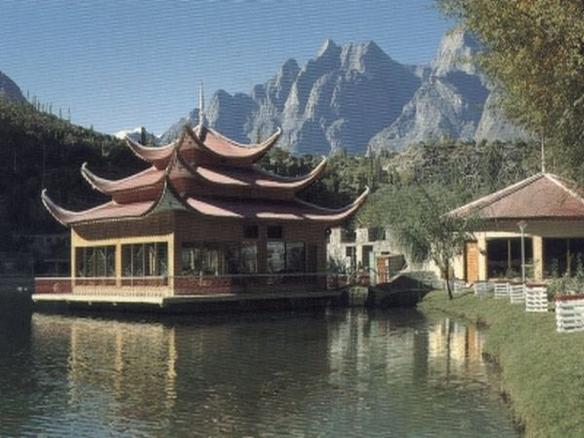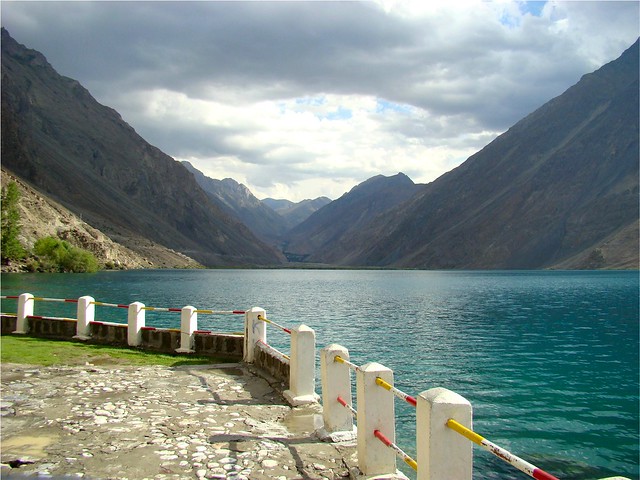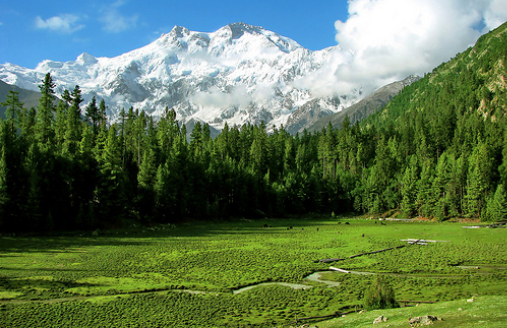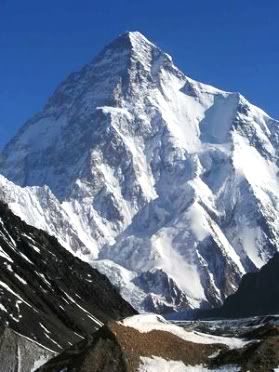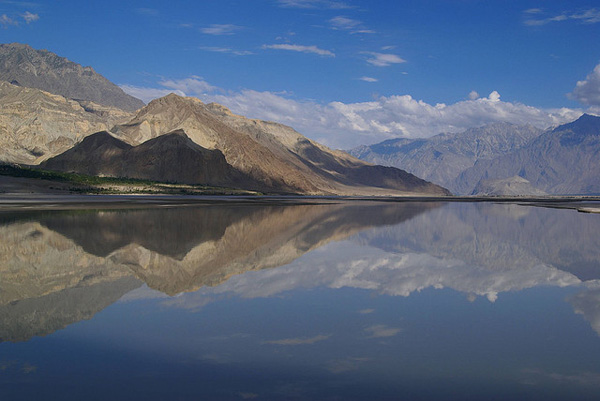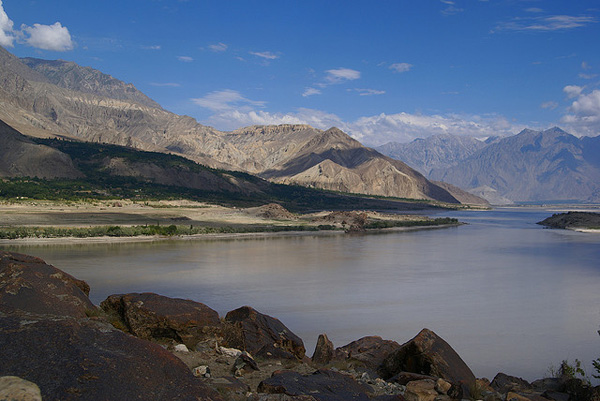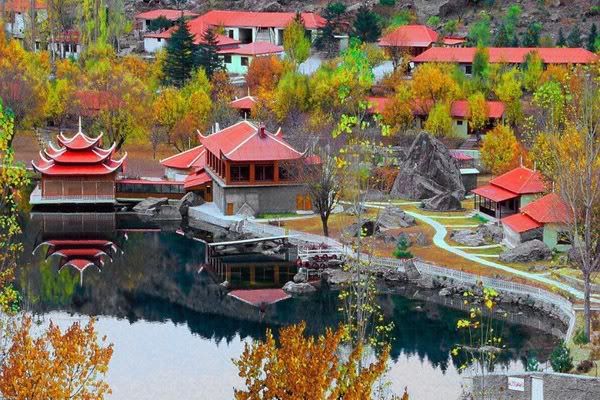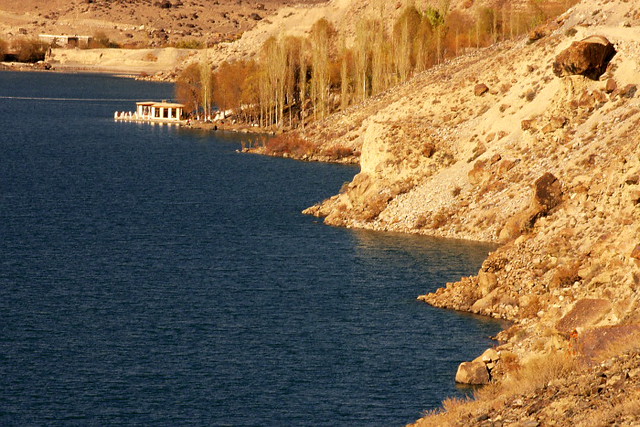Skardu Valley
Skardu (Urdu: سکردو, Balti: from Tibetan (Balti): skar rdo སྐར་རྡོ་ - "star stone, meteorite"), is the main town of the region Baltistan and the capital of Skardu District, one of the districts making up Pakistan's Gilgit–Baltistan.
Skardu is located in the 10 km wide by 40 km long Skardu Valley, at the confluence of the Indus river (flowing from near Kailash in Tibet and through neighbouring Ladakh before reaching Baltistan) and the Shigar River. Skardu is situated at an altitude of nearly 2,500 m (8,200 ft). The town is surrounded by grey-brown coloured mountains, which hide the 8,000 metre peaks of the nearby Karakoram range.
Skardu, along with Gilgit, are the two major tourism, trekking and expedition hubs in Gilgit–Baltistan. The mountainous terrain of the region, including four of the world's fourteen Eight-thousander peaks (8,000 m and above), attracts the attention of tourists, trekkers and mountaineers from around the world. The main tourist season is from April to October; outside this time, the area can be cut off for extended periods by the snowy, freezing winter weather.
Accessible from Skardu by road, the nearby Askole and Hushe are the main gateways to the snow covered 8,000 m peaks including K2, the Gasherbrums, Broad Peak and the Trango Towers, and also to the huge glaciers of Baltoro, Biafo and Trango. This makes Skardu the main tourist and mountaineering base in the area, which has led to the development of a reasonably extensive tourist infrastructure including shops and hotels. However, the popularity of the region results in high prices, especially during the main trekking season.
Treks to the Deosai Plains, the second highest in the world (at 4,100 m or 13,500 feet) after the Chang Tang in Tibet, either start from or end at Skardu. In local Balti language, Deosai is called Byarsa, meaning 'summer place'. With an area of approximately 3,000 square kilometres, the plains extend all the way to Ladakh and provide habitat for snow leopards, ibex, Tibetan brown bears and wild horses.
The town has developed along the main road passing through it and to either side of this road is situated the New Bazaar (Naya Bazaar), with hundreds of shops offer almost everything (trekking supplies, souvenirs, local goods, etc.). To the west one finds Yadgar Chowk (with local monument) and from there, the quarter behind Naya Bazaar, to the right hand side is the older Purana Bazaar. Travelling west from Naya Bazaar is a polo ground and next to that, Kazmi Bazaar.
Skardu appears remote, dusty town at first glance, but the mixture of people here make it colourful and ethnically diverse. The crowded streets are mainly populated by Balti Tibetans and many of the local neighbourhoods (mohallahs) have names that reflect this too (i.e. Khache-drong, Khar-drong, Olding, Kushu-bagh, Pakora, Thsethang, Sher-thang, Nagholi-spang etc.).
However, many other ethnic groups are present in Skardu including Shins, Pashtuns, Punjabis, Hunzakuts and even Uyghur, due to the close proximity of Baltistan to the respective regions. Since the creation of Pakistan people of various ethnicities from various regions of Pakistan have emigrated here.
All the above ethnic groups are devout Muslims. This includes the Balti-Tibetans, who converted from Tibetan Buddhism in the 16th century (the only sizeable group of Tibetans to have undergone such a conversion).
The climate of Skardu during the summer is moderated by its mountain setting and the intense heat of lowland Pakistan does not reach here. The mountains also block out the summer monsoon and summer rainfall is thus quite low. However, these mountains result in very severe winter weather. During the April to October tourist season, temperatures vary between a maximum of 27 °C and a minimum (in October) 8 °C. However, temperatures can drop to below -10 °C in the December-to-January midwinter period. The lowest temperature of the year can reach -25 °C.
Skardu is accessible by two methods, road or air. The normal road route into Skardu is via the Karakorum Highway and a linkroad into the Skardu Valley from it. There are also four or five other road links to Kashmir and Ladakh. Alternatively, there are normally one or two flights daily between Skardu Airport and Islamabad. The high cost of air travel means that road travel via the Karakorum Highway and the link road onward to the Skardu Valley is often the preferred option of locals and tourists alike.
The climate can have adverse effects on transport in and out of the Skardu Valley, as Skardu becomes snowbound during the winter months. Often the roads in and out of Skardu (and other Northern Areas locations) can be blocked for weeks at a time depending on conditions (though two to five days is more normal), sometimes leaving air travel as the only feasible alternative. However, air travel in winter is also subject to disruption due to the unreliable Skardu weather and flights can occasionally be delayed by several days.
The Satpara Dam development project on the Satpara Lake was inaugurated in 2002 and expected to be completed soon. It is 7 km away from Skardu city and its altitude is 8,700 feet (2,700 m) moreover it will also pond the water about 90,000 acre feet (110,000,000 m3). The main source of water is melting ice of the Deosai plains during the summer season.
It is a multipurpose project, which will produce 13 Megawatts hydro generation, irrigate 15,000 acres (61 km2) of land and also provide 13 cusecis drinking water daily to Skardu city.
Skardu Fort or Kharphocho Fort lies on the eastern face of the Khardrong or Mindoq-Khar("Castle of Queen Mindoq") hill 15 metres or 40 feet (12 m) above Skardu town. The fort dates from the 8th Century CE and contains an old mosque probably dating back to the arrival of Islam in the 16th Century CE. The fort provides a panoramic view of Skardu town, the Skardu valley and the Indus River. The fort was built by Rmakpon dynasty rulers of Baltistan and it was a seven storey building.
Kharphocho (Skardu) fort was built on a design similar to that of Leh Palace and the Potala Palace in Lhasa, Tibet. The name Kharpochhe means the great fort — Khar in Tibetan means castle or fort and Chhe means great.
Located on the route to the world’s second highest mountain K-2, is Shigar Fort. It is also known as Fong-Khar, which in the local language means the “Palace on the Rock”. The complex at Shigar comprises the 400-year-old Fort / Palace and two more recent buildings, the "Old House" and the "Garden House". The former Palace of the Raja of Shigar has been transformed into a 20 room heritage guesthouse, with the grand audience hall serving as a museum of Balti culture and featuring select examples of fine wood-carvings, as well as other heritage objects.
There are three lakes in the vicinity of Skardu. In local Balti-Tibetan language, a lake is athso or tso.
There are two Kachura Lakes—the less well known Upper Kachura lake and the more famous Lower Kachura Lake, better known as Shangrila Lake. Lower Katsura lake is home to the Shangrila Resort hotel complex (possibly the reason for the lake's alternative name), built in a Chinese style and another popular destination for tourists in Pakistan. The resort has a unique style of restaurant, set up inside the fuselage of an aircraft that crashed nearby. Kachura lake 18m from Skardu. Kachura Lake is famous for its deep blue waters. There are numerous places to visit and things to do near Kachura Lake, situated near Skardu in the northern area.
Satpara Lake is Skardu Valley's main lake. In 2002, the Government of Pakistan decided to build a dam on the Satpara Lake allocating $10 million to the Satpara Dam project, two years later in 2004. Progress on the project has, however, been slow. Satpara Lake is 6 miles (9.7 km) from Skardu. Satpara Lake is one of the largest fresh water lakes in the countryside offering trout fishing, and row boating. This lake is also the source of Skardu's drinking water.

